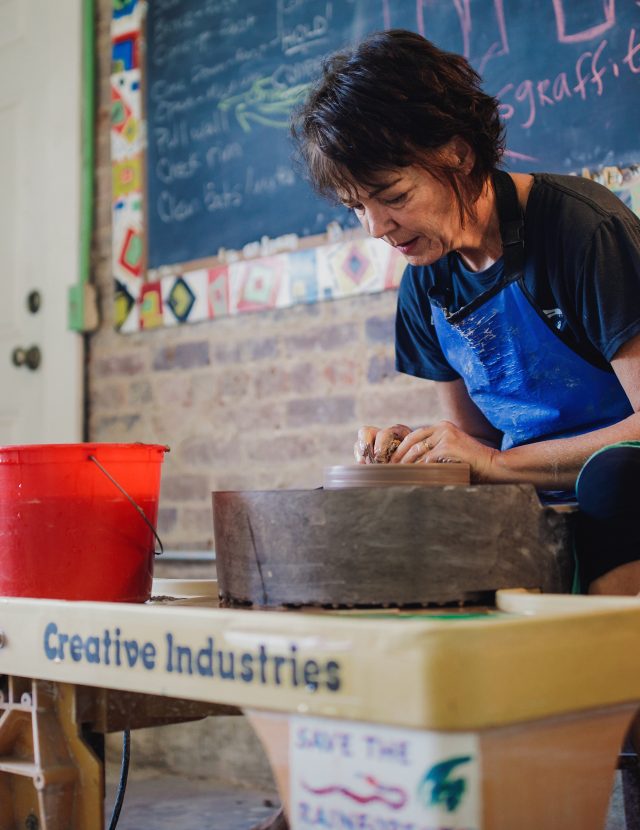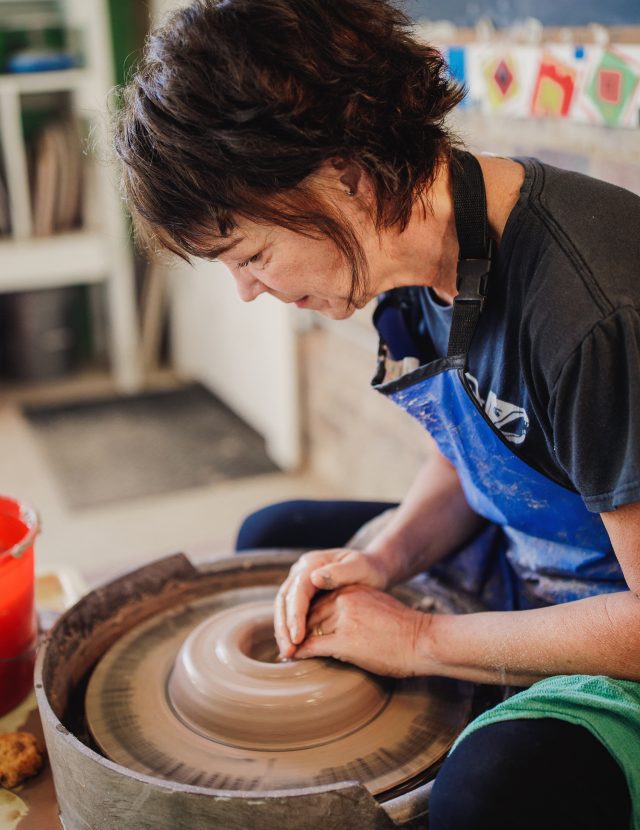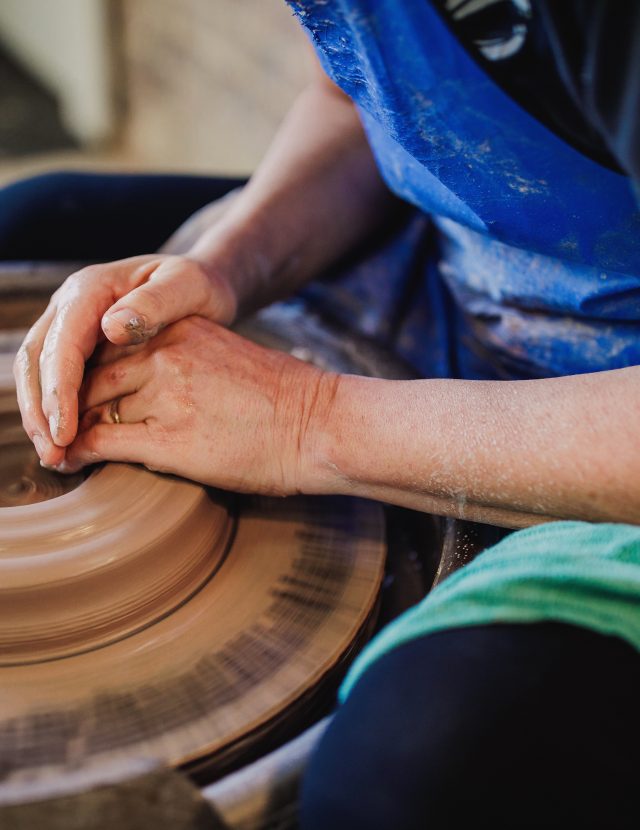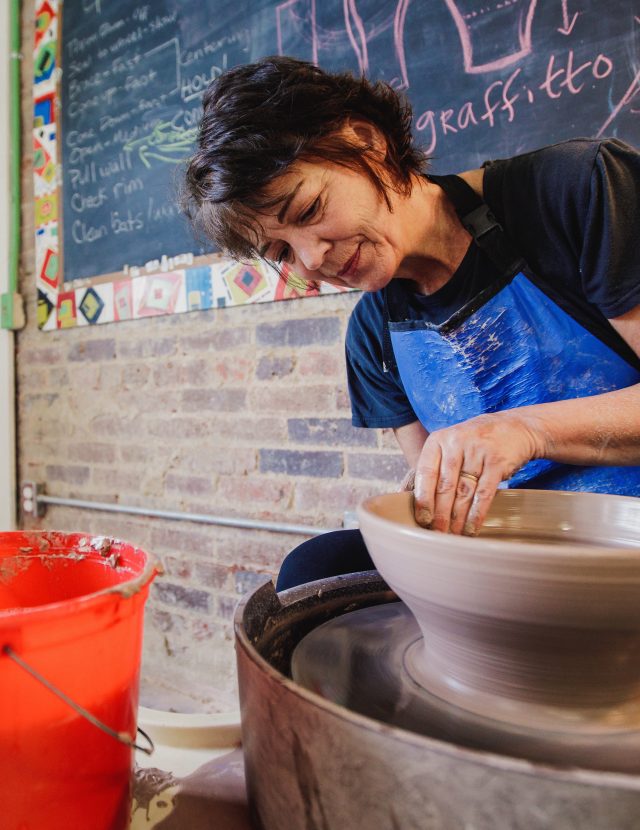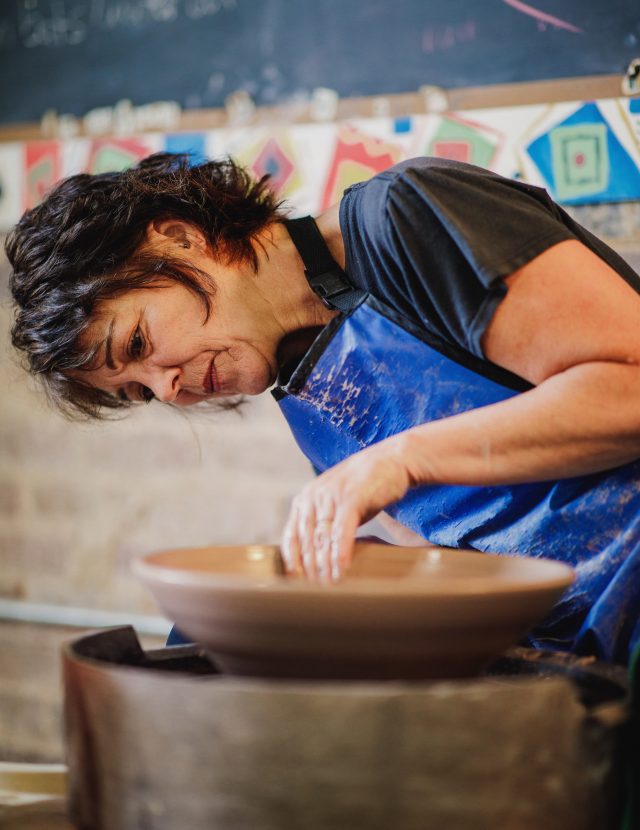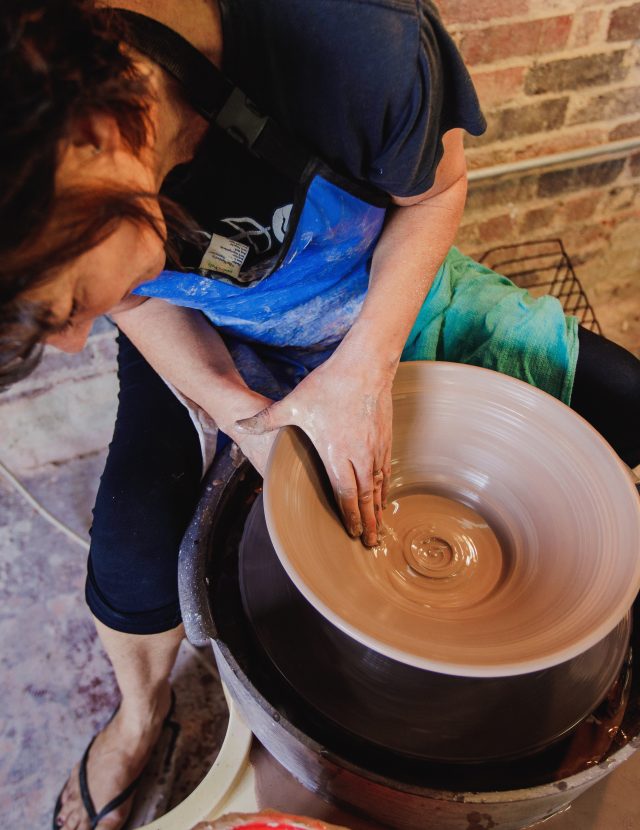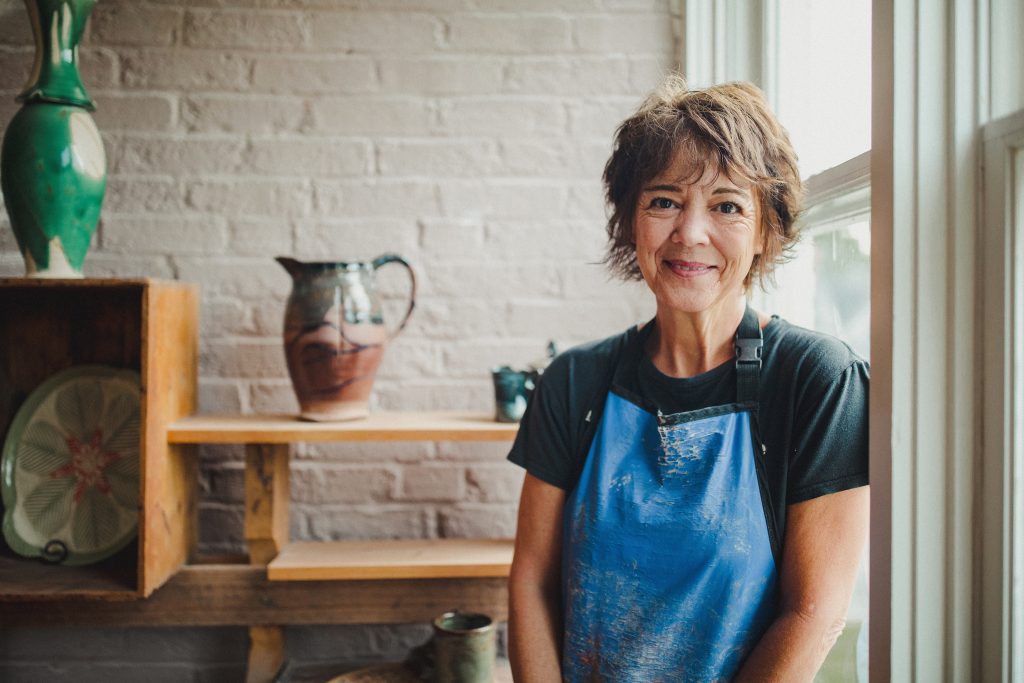
Photos Cameron Flaisch
Art has many meanings to different people. Some like the beauty of the discipline, some can see beneath the surface and find meaning in a piece, and some people admire the amount of time and work put into the piece. All art takes talent, especially those who choose to try pottery. Pottery is not something you can expect to grant immediate gratification. Pottery is art that takes discipline to master.
Meet Janda Canalis, owner, operator and instructor of EarthWorks Pottery. Canalis, who is also a retired high school teacher with the Floyd County College and Career Academy, has been in business for 20 years. She started her journey due to her love of pottery, a passion she still wishes to share with her community. To open the studio, Canalis acquired equipment, little by little, and networked with other artists who wanted to learn more about pottery.
Then came the obvious step. “It takes a lot of practice,” says Canalis when remembering the early years of her studio.
“As adults, we like to stay in our comfort zones and do stuff that they’re good at right away. With clay, it’s a little humbling because it takes a while to get it, and like anything else in the world, it takes practice,” she explains. “For me, the passion is that I work together with the clay to help me grow as a person. It helps me to get centered. The clay allows me to shut out the world for a little while and balance myself. Then, it’s gratifying knowing that the clay is a part of the earth and not something manmade.
“I’m actually taking something from the earth and recycling it into something new that people can enjoy,” Canalis continues. “People think pottery is just something that you do with your hands, and physically it is, but its also something you do with your spirit. You have to center the clay, but you must also be centered. Like if you are having a bad day or your mind is not focused, it just will not work. You must achieve some type of peaceful state.”
As a potter, she loves teaching and she makes that clear. “I’m a teacher at heart; I love to teach. That’s why I started my studio. I want to share my passion.”
EarthWorks has 10 stations set up for students. There, students can learn the basics of operating the wheel. While classes are mostly for adults, EarthWorks does offer opportunities for summer classes for children. She offers beginning and intermediate classes to any age, from school-aged children to adults.
Some EarthWorks students have been with Janda for 20 years. “A lot of people have purchased kilns and wheels at home, and have their own thing going. They have still continued to come here for classes because it’s a community and we grow through each other. When you’re home alone, you don’t quite have that comradery and the people around you to lift you up the way you would in this setting. I love that people still come to the studio and are willing to grow in pottery” Canalis explains.
The effects of art outside of the end piece is also motivation for why Canalis does what she does. “One of my greatest rewards of teaching pottery, and the reason I teach instead of doing my own thing, is the seeing of the emotional effect and seeing the feeling of centeredness and being one with the clay in someone else. To think that I can help someone facilitate those feelings, is a great reward. Initially people don’t realize that working with clay is therapeutic, but once they get in here and feel the internal fulfillment as well as see something that they have created, I think then is when they decide to stick with it. We celebrate and encourage each other. There’s a lot of positive feedback and positive feelings in watching others success. Its emotional and in its own way, spiritual to see someone become centered and one with the clay, then they have that ‘ah-ha’ (I got it!) moment. In the end, if they get bitten by the pottery bug and they love it, that’s great and I’ve had people go on to be really talented potters.”
Additionally, pottery has physical health benefits also. It helps with arthritis and keeps seniors’ hands and wrists flexible due the actions required to handle the clay.
Pottery requires patience, a good state of mind and the understanding that you won’t always achieve your desired result. “I try to get people to not get so attached to the product, but to get attached to the process. Because there are so many steps in which the piece could crack, or the glaze doesn’t turn out how they thought, it would be very disappointing if you put all of your energy into the end piece hoping it is going to be perfect,” explains Canalis.
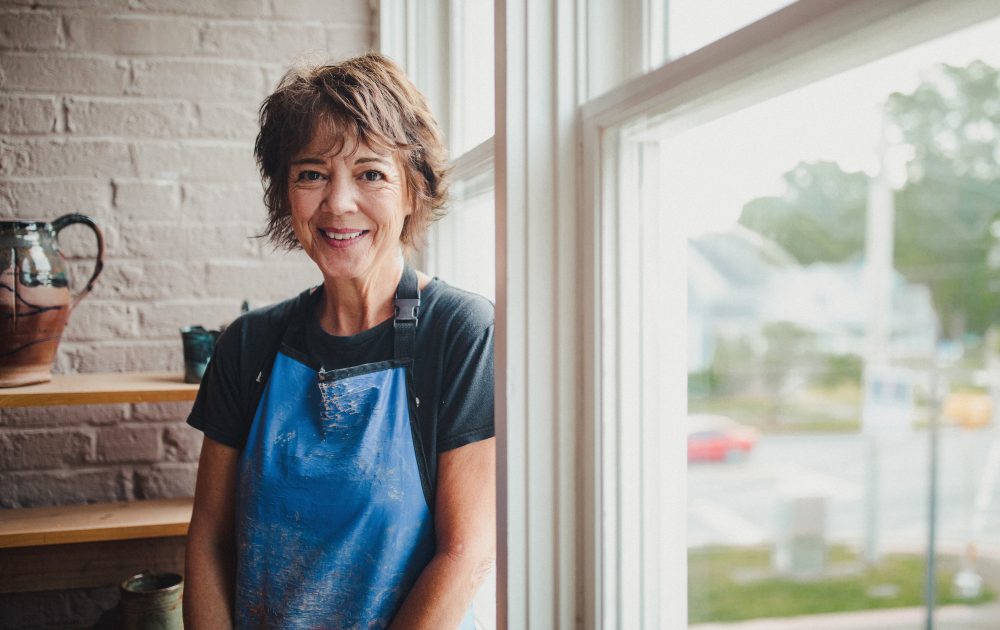
“Every time something flops, you grow. I always try to help my students understand that. You can learn from every mistake. If you took it too far and made the wall too thin, next time you know what adjustment to make, but you can’t learn unless you make some mistakes, to know how far you can push the clay.”
The process is not an easy nor a short one. The clay is placed onto the wheel. Then the beginning step is centering the clay. “Sometimes, people think centering is putting it in the center,” Canalis says when explaining the process, “but it’s the inside of the clay where all of the molecules are that must get centered so that the rest of the vessel will be symmetrical.”
“In the beginner stages,” she continues, “people tend to attack the clay, like working at it. As they relax a little bit, then they realize the clay and the wheel will do more for them than they think.”
It takes quite a bit of time to center the clay. Next, one must open up the vessel (depending on what being made). If it a wide vessel, you’d open it further, if it’s a tall vessel you open it narrow. The next step is called pulling up the wall. It is a difficult step for beginners. It requires lots of support, encouragement and practice. The wall has to be the same thickness all the way up. If its thin, thick, thin, and thick again, then its guaranteed to break. Lastly, you must open the vessel up, and you can form it to whatever you want to create.
After creating your form, the vessel must be dried. The drying process is also long process. If the vessel dries too fast it will crack. Drying, depending on the size of the vessel, can take a week. If it’s a plate, two weeks. And that’s just the drying process.
Next the vessel goes into the kiln. The vessel goes through the first firing, which is called the bisque firing. This firing allows the vessel to get to the point that you can apply glaze to it. The vessel is still not strong enough for usage yet. The bisque stage takes 24 hours. Once the vessel comes out of the bisque firing, you glaze it. The glazes are like putting glass on the vessel. It melts in the hot kiln. This is called the glaze fire, which is a higher temperature. The vessel then has to cool down, which takes another 48 hours. Once this time has passed, you have your finished piece.
Canalis wants everyone to appreciate the work and the process of each piece of pottery. “When people go to the fair or art markets and see pottery, I wish they would pick the pieces up. They should feel them and admire them. There’s so much heart in it. The soul of the potter is in it. You have to understand all that goes into a piece. Then consider the joy of someone valuing that work of the potter. I’d also like people to support people who are still trying to stick to the basics. Yes, you can buy plates and mugs for cheap at a local department store, but also remember to support people who are still trying to stick to the basics and create something uniquely beautiful.”
Art, pottery and teaching are a true passions for Canalis. It is also therapeutic to her in many ways. There is an emotion in dealing with clay, and more so when dealing with people who are looking for peace. “Most of my creations are emotionally motivated. I especially like to create bowls, particularly large bowls. They are my absolute favorite item to create. When you give someone a bowl, you figure they are going to fill it with something. To know that you created something that someone could be using to serve food to their family, or imagining that something else great will go into it is gratifying. I don’t know, there’s just something that feels real and expressive to me about a large bowl. “
I feel like bowls are just very generous and open, and sometimes I need that as I am an introvert. I’m kind of into myself and I need my space, and I come in here to the studio and it opens something deeper inside of me. I think that every time I sit at that wheel, things are more than just okay. In fact, something else about this place is that time becomes totally different. You can look up at the clock and not believe that three hours have passed. Its timeless, I’ll never have enough time here.”
Canalis sells some of her creations at various events in Northwest Georgia, like Chiaha Harvest Festival and at auctions. She hopes to be able to sell more pieces as she enters her retirement years. There is also an art gallery at the EarthWorks’s studio. Her goal is for EarthWorks to become a big part of the community and hopes to grow the classes. “ EarthWorks is a supportive and encouraging environment where you can try something new. We would love to grow.”
Without a doubt, pottery is an art discipline that has no limits.

